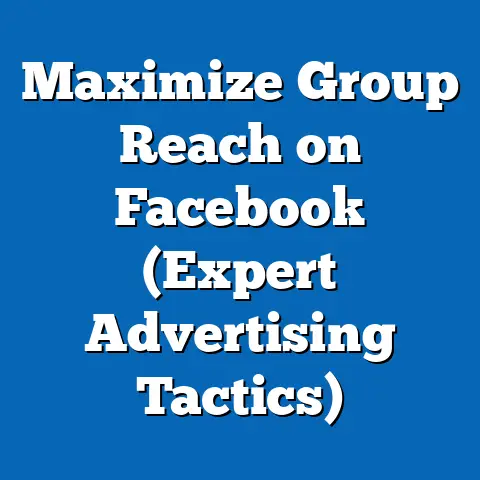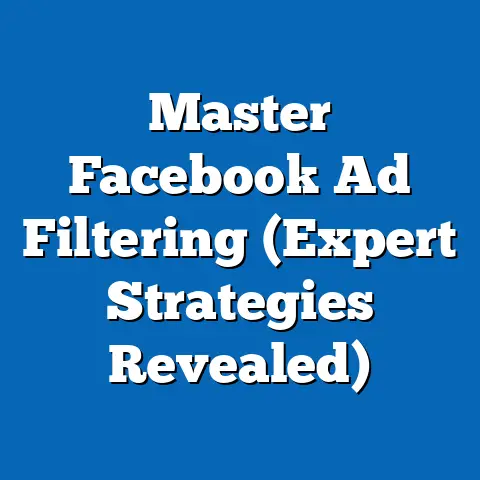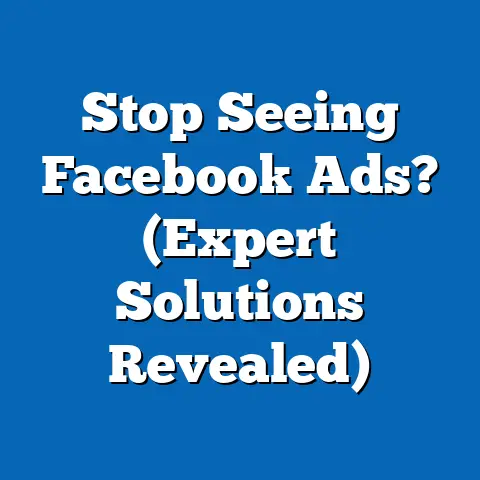Run Instagram Ads Without Facebook? (What You Need to Know)
The digital advertising landscape is a constantly evolving beast. Social media platforms, once simple spaces for connecting with friends and family, are now powerful marketing engines. Instagram, in particular, has undergone a remarkable transformation. Starting as a humble photo-sharing app, it has matured into a robust advertising platform, offering brands a direct line to their target audiences. As Instagram continues to innovate, adding new ad features and capabilities, a crucial question arises for marketers: Is it truly possible to run Instagram ads without the need for a Facebook account?
Having navigated the intricacies of Facebook and Instagram advertising for years, I’ve witnessed firsthand the shifts in how these platforms operate. In this article, I’ll delve into the relationship between Instagram and Facebook, explore Instagram’s independent advertising features, weigh the benefits and limitations of this new approach, and ultimately, offer insights into the future of Instagram advertising.
The Relationship Between Instagram and Facebook
To understand the current landscape, it’s crucial to revisit the history. Facebook’s acquisition of Instagram in 2012 was a pivotal moment, setting the stage for the advertising integration we’ve known for years. For a long time, Facebook Ads Manager served as the primary, and often only, tool for creating and managing Instagram ad campaigns.
This integration offered significant advantages. The Facebook Ads Manager provided access to incredibly powerful targeting options, leveraging the vast data collected across both platforms. You could target users based on demographics, interests, behaviors, and even custom audiences built from website traffic or customer lists. The unified platform also streamlined analytics, allowing marketers to track campaign performance across both Facebook and Instagram from a single dashboard.
However, this integration wasn’t without its drawbacks. Managing two platforms through a single interface could feel cumbersome, especially for businesses whose primary focus was Instagram. The complexity of the Facebook Ads Manager could also be overwhelming for newcomers, leading to inefficient campaigns and wasted ad spend. I remember helping a local bakery set up their first Instagram ads. They were initially excited, but after logging into the Ads Manager, they were completely bewildered by the sheer number of options and settings. It took a significant amount of time and patience to guide them through the process.
Key Takeaway: Historically, Facebook Ads Manager has been the central hub for Instagram advertising, offering powerful targeting and analytics but also introducing complexity for Instagram-focused businesses.
Instagram’s Independent Advertising Features
The winds are changing! Recognizing the growing importance of Instagram as a standalone advertising platform, Meta (Facebook’s parent company) has introduced features that allow advertisers to run Instagram ads directly within the app, without necessarily relying on Facebook.
These features empower businesses to create and manage campaigns, target specific audiences, and utilize Instagram’s unique ad formats (Stories, Reels, Carousel, etc.) all within the familiar Instagram environment.
Here’s a step-by-step guide on how to create an ad using Instagram’s native features:
- Account Setup: Ensure your Instagram account is set up as a professional account (either a Business or Creator account). This gives you access to advertising features and analytics.
- Promote an Existing Post: The simplest way to create an ad is to promote an existing post. Choose a post that resonates with your audience and aligns with your marketing goals.
- Set Your Objective: Instagram will prompt you to choose an objective for your ad. Common objectives include:
- More profile visits: Encourages users to visit your Instagram profile.
- More website visits: Drives traffic to your website.
- More messages: Starts conversations with potential customers.
- Define Your Audience: This is a critical step. You can choose to:
- Automatic Targeting: Instagram will target users similar to your existing followers.
- Create Your Own: Define your target audience based on:
- Location: Target users in specific cities, regions, or countries.
- Interests: Target users based on their interests and activities on Instagram.
- Age & Gender: Refine your audience based on demographics.
- Set Your Budget and Duration: Determine how much you’re willing to spend and how long you want your ad to run. Instagram will estimate the reach based on your budget and targeting.
- Review and Submit: Carefully review all the settings before submitting your ad for review.
- More profile visits: Encourages users to visit your Instagram profile.
- More website visits: Drives traffic to your website.
- More messages: Starts conversations with potential customers.
- Automatic Targeting: Instagram will target users similar to your existing followers.
- Create Your Own: Define your target audience based on:
- Location: Target users in specific cities, regions, or countries.
- Interests: Target users based on their interests and activities on Instagram.
- Age & Gender: Refine your audience based on demographics.
- Location: Target users in specific cities, regions, or countries.
- Interests: Target users based on their interests and activities on Instagram.
- Age & Gender: Refine your audience based on demographics.
Key Takeaway: Instagram now offers native advertising features, allowing businesses to create and manage campaigns directly within the app, simplifying the process for Instagram-focused marketers.
Benefits of Running Instagram Ads Independently
The shift towards independent Instagram advertising unlocks several key benefits, particularly for brands that prioritize the platform.
- Streamlined Advertising Process: For businesses primarily focused on Instagram, managing campaigns directly within the app simplifies the entire advertising process. No more navigating the complexities of Facebook Ads Manager!
- Enhanced User Experience: Creating ads within the familiar Instagram environment is more intuitive and user-friendly, leading to a more efficient and enjoyable experience.
- Direct Engagement with the Instagram Community: Independent ads allow for more direct engagement with the Instagram community, fostering stronger relationships with potential customers.
- Empowering Small Businesses and Influencers: This shift levels the playing field, making it easier for small businesses and influencers with a strong Instagram presence to run effective ad campaigns.
I’ve seen this firsthand with several local businesses. A clothing boutique, for example, was initially hesitant to invest in Facebook ads because they didn’t have a strong Facebook presence. However, they were thriving on Instagram. By leveraging Instagram’s native ad features, they were able to quickly and easily create targeted campaigns that drove significant sales.
Key Takeaway: Running Instagram ads independently streamlines the process, enhances user experience, fosters direct engagement, and empowers small businesses and influencers.
Limitations and Challenges of Independent Instagram Advertising
While the move towards independent Instagram advertising offers significant advantages, it’s essential to acknowledge the limitations and challenges.
- Limited Access to Advanced Targeting Options: Compared to the Facebook Ads Manager, Instagram’s native ad features may offer fewer advanced targeting options. This could limit your ability to precisely target specific audience segments.
- Reduced Analytics Capabilities: While Instagram provides basic analytics within the app, the reporting capabilities may not be as comprehensive as those offered by Facebook Ads Manager. This could make it more difficult to track campaign performance and optimize your strategy.
- Inability to Retarget Users Effectively: Retargeting, a powerful advertising technique that allows you to show ads to users who have previously interacted with your brand, may be more limited on Instagram compared to Facebook’s robust retargeting system.
- Potential Impact on Campaign Performance: These limitations could potentially impact campaign performance, especially for businesses that rely on advanced targeting and in-depth analytics.
For instance, a tech startup I worked with relied heavily on retargeting website visitors with tailored ads. While they could run ads on Instagram, the retargeting capabilities were not as granular as they were on Facebook, leading to a slightly lower conversion rate on Instagram.
Key Takeaway: Independent Instagram advertising has limitations in advanced targeting, analytics, and retargeting, which could impact campaign performance for businesses that rely on these features.
The Future of Instagram Advertising
The future of Instagram advertising is bright, driven by ongoing innovation and the ever-evolving needs of marketers. I anticipate seeing the following trends shape the landscape:
- Integration of More Advanced AI Tools: Expect to see more sophisticated AI-powered tools that automate ad creation, targeting, and optimization.
- Enhanced User Engagement Features: Instagram will likely introduce new ad formats and features that encourage greater user engagement, such as interactive polls and quizzes.
- The Growing Role of Influencers: Influencer marketing will continue to be a dominant force on Instagram, with brands increasingly partnering with influencers to reach their target audiences.
As Instagram continues to carve out its niche in the digital advertising landscape, it will offer exciting opportunities for brands willing to adapt and embrace its evolving capabilities. Staying informed about changes in the platform and experimenting with new features will be crucial for success.
Key Takeaway: The future of Instagram advertising will be shaped by AI, enhanced user engagement, and the continued dominance of influencer marketing. Stay informed and adapt to thrive!
In conclusion, while Facebook Ads Manager has traditionally been the go-to platform for Instagram advertising, the introduction of Instagram’s native ad features marks a significant shift. It empowers businesses, especially those with a strong Instagram presence, to streamline their advertising efforts and engage directly with their target audience. While limitations exist in terms of advanced targeting and analytics, the benefits of simplified ad creation and enhanced user experience are undeniable. As Instagram continues to innovate, it will undoubtedly become an even more powerful and independent advertising platform, offering exciting opportunities for brands willing to embrace the change.






